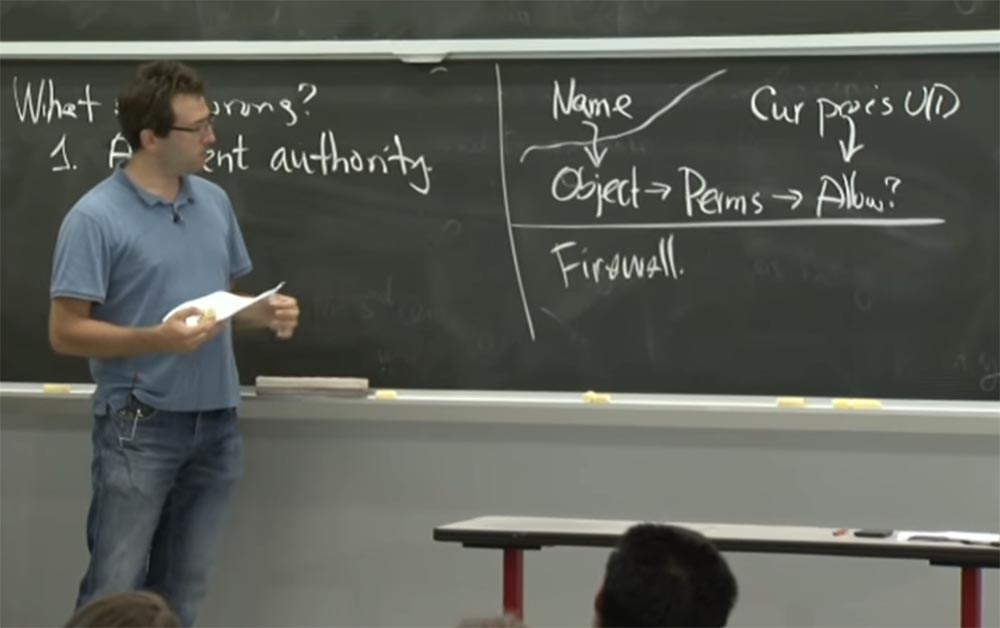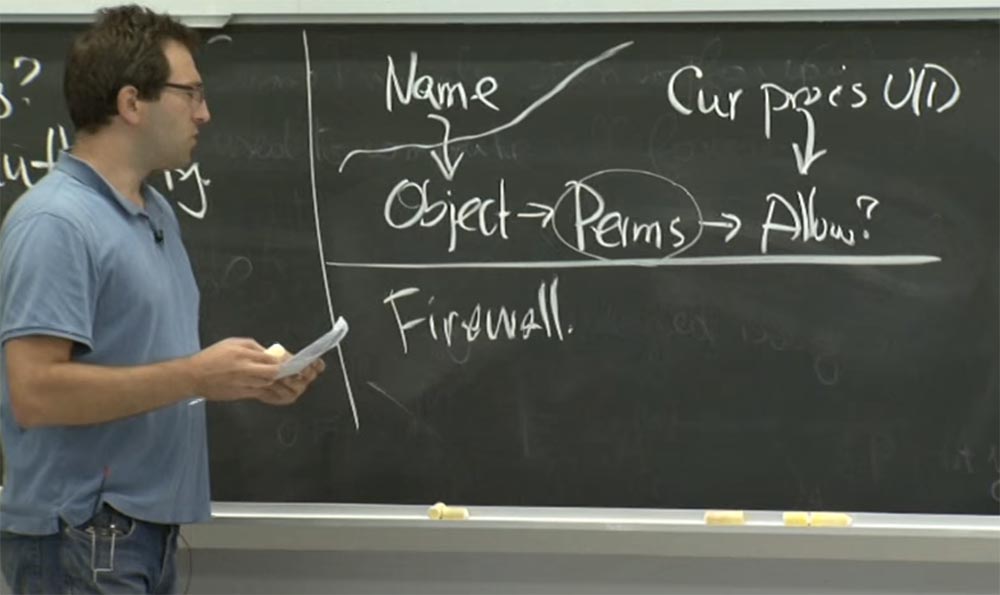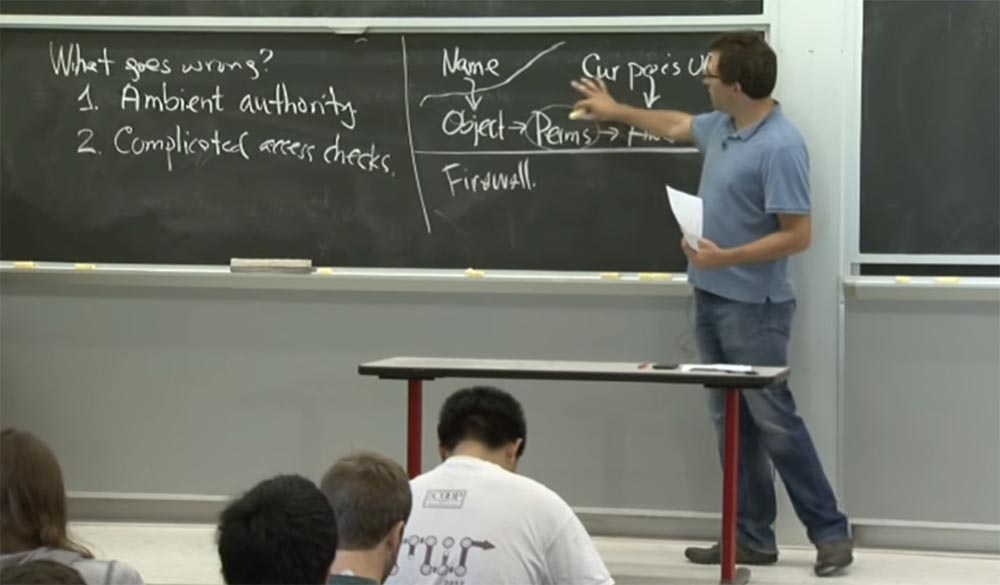MIT course "Computer Systems Security". Lecture 6: "Opportunities", part 1
Massachusetts Institute of Technology. Lecture course # 6.858. "Security of computer systems". Nikolai Zeldovich, James Mykens. year 2014
Computer Systems Security is a course on the development and implementation of secure computer systems. Lectures cover threat models, attacks that compromise security, and security methods based on the latest scientific work. Topics include operating system (OS) security, capabilities, information flow control, language security, network protocols, hardware protection and security in web applications.
Lecture 1: "Introduction: threat models" Part 1 / Part 2 / Part 3
Lecture 2: "Control of hacker attacks" Part 1 / Part 2 / Part 3
Lecture 3: "Buffer overflow: exploits and protection" Part 1 / Part 2 / Part 3
Lecture 4: "Separation of privileges" Part 1 / Part 2 / Part 3
Lecture 5: "Where Security Errors Come From" Part 1 / Part 2
Lecture 6: "Opportunities" Part 1 / Part 2 / Part 3
So, in the continuation of the topic of the division of privileges, today we will talk about the possibilities. If you remember, last week we talked about how Unix provides some mechanisms for applications that can be used if we need to separate privileges from the internal structure of the application.
')
Today we will talk about the possibilities that will make us think very differently about the privileges that the application may have. Therefore, in today's lecture, we have two separate issues for discussion. One question concerns how to avoid confusion in determining authority and to make your privileges when writing a program more clear and unambiguous, so that you do not accidentally use the wrong privileges.
The second question concerns the sandbox called Capsicum , this is a system similar to OKWS , which allows you to run a code fragment with lower privileges. Therefore, if the system is compromised, it will not be in danger of great damage.

This approach will allow you to manipulate privileges differently than Unix allows. To begin with, let's take a look at this confusing problem of authority that the author of the article in question, Norman Hardy, has encountered, and find out why she puzzled him so.
This article was written a long time ago, and the author uses the syntax for file names, which is a bit surprising. But we can try, at least, to transcribe his problem into a more familiar Unix -style name syntax.
As far as I can tell, he used the Fortran compiler , which was in / sysx / fort , and he wanted to change this compiler to keep statistics on what was compiled, which parts of the compiler were the most resource-intensive, and so on. So he wanted to make sure that this Fortran compiler would somehow write to the / sysx / stat file and that he would write here information about various compiler calls.

Their operating system had something like the setuid function that we talked about in Unix . They called it a license for home files. This meant that if you started / sysx / fort , and this program had a so-called home files license, then this process that you just started will have additional write access to everything in / sysx / . That is, you could write everything after a slash that is usually marked with an asterisk, getting an expression like / sysx / * . This gave access to all files written in the directory after / , and the user could run them. Therefore, the specific problem they encountered was that some clever user could do this by running the compiler could take a lot of arguments like GCC does.
Such a user could, for example, collect something like foo.f , where f is the source code of Fortran , and add here - o / sysx / stat .

They had another file in the system / sysx , which was a billing file for all the clients of the system. His damage would do even more damage. It was possible to similarly “ask” the compiler to compile the source file / sysx / bill and place it in some special file in / sysx . And in their case, it worked. Despite the fact that the user himself did not have access to an entry in this file or directory, he used the compiler, which had this additional privilege - a license for home files. Thanks to the privileges of the compiler, he was able to replace files contrary to the intentions of the developer.

Who should they blame for what happened? What did they think went wrong? Was it possible to act differently in order not to encounter such problems? They believed that the Fortran compiler would be very careful when it uses its privileges. In fact, at a certain level, the Fortran compiler has two types of privileges that it enjoys.
One, the main one, is based on the fact that if the user called the compiler, then he should be able to access the source file, such as foo.f. And if it was some other user who did not activate, or did not call the compiler, then such a user would not be able to access the source code of the “correct” user.
The second type of privilege is provided by this license itself, which allows you to write these special files. On the internal level of the compiler's source code, there should have been clear indications of which of these privileges he wants to use when opening a file or when performing some privileged operation. He could just open, read and write files, like any other program. He implicitly uses all the privileges he has, that is, in their system design, it was a kind of combination of user privileges and a license to use home files.
So these guys were really interested in solving this problem. And they sort of called this compiler "stupid assistant," because he had to distinguish between the many privileges that he had and carefully use them when needed.
So, we should consider how to develop a similar compiler in Unix . In their system, everything was tied to this file license. There are other mechanisms that they later introduced into their program to identify opportunities, we will talk about them in the near future. But can we solve this problem on a Unix system?
Suppose you need to write this Fortran compiler on Unix , write this special file, and avoid the problems that arise. What would you do? Any ideas? I think you can just declare it a bad plan, and, for example, do not keep statistics. Or do not support data entry type - oh . On the other hand, you can specify which source code you want to compile so that you can read the / bill file or the statistics file, which may need to be secret.
Or maybe you could provide support for standard source code, but then it would have to contain parts of another source code, so this is a bit abstruse.
Audience: it would be possible to share the privileges of the compiler.
Professor: Yes, it would be another potentially good design that shares his authority. We know that in fact the Fortran compiler does not need both privileges at the same time. So, perhaps, speaking in the Unix language, we could create a compiler like world / bin / fortcc , and it would be just an ordinary program without additional privileges. And then we would create / bin / fortlog , which will be a special program with some additional privileges, and it will collect statistics about what happens in the compiler, and the function fortcc will call the fortlog . So, what privileges would we give this fortlog ?

Audience: maybe if you use something like setuid or fortlog , then any other user will also be able to register through it any arbitrary data.
Professor: yes, so this is not so great. Because the only way in Unix to give additional privileges to fortlog is to become its owner, I don't know, maybe create a fort UID and setuid . And every time you run fortlog , it switches to this fort UID . And, perhaps, some special statistical file is also needed here. But then, because everyone can call this fortlog .

And this is not good, because anyone can write to the statistics file. In this case, for security, this is a small problem, but what happens if, instead of stat, it is a bill payment file? In this case, the problems will be much more serious.
In Unix, there is a rather complex mechanism, the consideration of which we missed at the last lecture on Monday. This mechanism allows the application to switch between multiple uids . Thus, to perform different applications, you can switch between user IDs . It is a bit difficult to implement in the right way, but doable. So this mechanism may be another potential design of our system.
I think you could do another trick: make the fortlog “binary” executable only for a specific group and create a binary file, fortcc setgid, for this group. However, this is not very good, since it erases any list of groups that the user originally had. But who knows, maybe this is better than nothing.
In any case, this is a rather complicated problem, but it can be completely solved with the help of Unix mechanisms. Perhaps you should rethink your problem and not worry too much about the stat statistics file, putting its security first. What happens wrong in our project?
There are two things to watch out for if something went wrong. The first is called ambient authority , or external authority. Does anyone understand what they mean? They never gave it a precise definition.
Audience: This means that you have the authority given to you by the environment. So, as if you are a user, acting without restrictions.
Professor: yes, you are performing an operation, and you can indicate which operation you want to perform, but the decision on whether this operation will be successful comes from some additional indirect parameters in your process.
In Unix, you can figure out what the ambient authority check will look like. Therefore, if you are making a system call, you probably gave the system call some name. And inside the kernel, this name is associated with some object. And this object supposedly contains within itself some kind of access control list, for example, permissions for this file and so on.

Thus, there are some permissions that you can get from this object, and you need to determine whether an operation with this name that was granted to the application will be allowed, that is, the chain Name -> Object -> Permission is created . This is what the app gets to see the process.
Inside the kernel there is a current user ID of the Process process UID process that makes calls. He is also involved in deciding whether to allow the execution of a specific operation or not. Thus, this current process user ID is an external privilege. Any operation you want to perform will be attempted by the kernel to check using your current UID , and your current GID , and any other additional privileges that you may have. And while there is some set of privileges that allow you to do this, you can do it. Although it is possible that you do not want to use all these privileges to open a specific file or to do some other operation.
Do you understand what these ambient privilege , external privileges are? In the case of the operating system, this means that the process has some kind of user ID. Can you give examples of such privileges not related to the operating system? For example, when you perform a process identification operation to find out if it was successful or not. Firewall is an example of this - if you are inside the network or have an internal IP address, you are allowed some operation, and if you are outside the network, the same operation will be prohibited for you.
Let's say you visit some website that contains a link to another server, and maybe you do not want to use the privileges that you have to go through this link. Because, perhaps, this will give someone access to your internal network printer and this someone will be able to use it. But in reality, the one who provided you the link should not get to your printer, because it is located outside the network. Or your browser firewall by visiting this link will be able to do it fraudulently.

This is a kind of moral equivalent of this confusing problem in network models.
Audience: existing permissions also affect this.
Professor: yes.
Audience: because in Capsicum , in essence, DAC is used — discretionary access control.
Professor: yes, this is largely because the guys from Capsicum use something like discretionary access control. This means that the user or owner of the object decides how the security policy will look for this object. For Unix, this is very natural - these are my files, and I can decide what I want to do with them, I can give them to you or keep them. Thus, almost all DAC systems look like this because they need some permissions that the user can modify to manage the security policy of their files.

The downside of DAC is mandatory access control. We will talk about this later, but at some level, these systems have a very different view of the world around them. They think that you are only a computer user, and someone else sets a security policy for using this computer. This look came from the 70s or 80s, when the military really wanted to have secret computer systems in which you work on some things that are marked as “secret”. And if you are working on things that are marked as “secret” , and I - on things with a “top secret” mark, then they cannot be so easy for you to get. But I don’t have to set file permissions and so on; it’s just not allowed by some top-level guy.
Thus, the mandatory access control is really trying to put different types of access policies in the first place, where there is a user and there is an application developer, and besides them, there is another guy who sets this policy. However, as you can guess, this is not always the case. We will talk about this a little later. But this is the mandatory meaning of discretionary access control.
We have many other examples of using external access control. This is not necessarily a bad thing; you must be very careful when using it. If you have an ambient privilege system, you need to be very careful when performing privileged operations. You have to make sure that you really use the right credentials and you will not be accidentally deceived, as with this Fortran compiler almost 25 years ago.
So this is one of the interpretations of what is happening. And this is not necessarily the only way to think about what goes wrong, right? Another possibility is that it would be nice if the application itself knew whether it should access the file on behalf of some principle. Therefore, problem number 2 is the difficulty of checking access control.

In a sense, when the Fortran compiler is running, it opens the file on behalf of the user, and you need to repeat the same logic that we see here in the diagram, except that the Fortran compiler must connect something else for the Cur process UID . Instead of using current privileges, he should simply repeat the check Name -> Object -> Permission and try to do it with a different set of privileges for the ur process UID .
On Unix, this is quite difficult to do because there are many places where security checks take place. If you have symbolic soft links, the symbolic link is viewed, and the path name is also evaluated with some privileges, and so on. But it may happen that in some system you could simplify access control checks if it can be done independently in the application. Do not you think that this is a reasonable plan? Would you agree with that? Is there a danger of repeating this check?
Audience: if you do checks in the app, you could simply not do other checks.
Professor: yes, you can easily skip the other checks, this is absolutely true. So in a sense, when they used the Fortran compiler here, he didn’t even try to do any checks, so they failed. Another consequence, in addition to the lack of checks, is that the kernel can change all the time, and then it will have slightly different checks. This will introduce some additional security requirements, but the application will not change and will implement the old style of checks. So this is not a good plan.
Recall that there is one good idea in the field of security - reducing the number of mechanisms involved. Therefore, the program has only a small number of places where security policies are applied. You probably do not want to repeat the same functionality in applications, in the kernel, and so on. You really want to focus these checks in one place of the program. So what should be the solution to the problem of granting authority?
Unix file descriptors come closest to solving the problem.

In the world of possibilities, an alternative to this scheme is that instead of following the Name -> Object -> Permission chain and deciding whether to allow its use based on the external credentials of the Cur process UID , you can use a very simple scheme.
Suppose you have capabilities related to a particular object. , .

, , . . , , , .
, Capability , , , , . . Capability , - , — .
Capability , . , ?
, , . , . , , .
, , , « ». , , Capsicum ? ?
: , , , Capability .
: , , , , . — . Unix , 0, , 1, . . , , . , - , , . PID , , PID:57 , . , , . , , , , , .. .

, , , . , -, - , .
, , , Unix , , , /etc/pwd .
. . , . , « »?

, , integer . , . , .
, . , ? , . , .
, , Capability , Fortran . sysx/fort ? , ?
: , . , , output- . , , .
Professor: yes it is. , Fortran /sysx/stat . , .
, , . , , «» Unix . , , , Fortran , , , , , .
. fort1 , , - , , foo.f , , , — o , . , . , .
, , , . ! , , , , setuid Fortran .

, setuid - , . , . , , , , .
, , , , . , , , Capability , , , , .
26:30
Continued:
MIT course "Computer Systems Security". 6: «», 2
Full version of the course is available here .
Thank you for staying with us. Do you like our articles? Want to see more interesting materials? Support us by placing an order or recommending to friends, 30% discount for Habr users on a unique analogue of the entry-level servers that we invented for you: The whole truth about VPS (KVM) E5-2650 v4 (6 Cores) 10GB DDR4 240GB SSD 1Gbps from $ 20 or how to share the server? (Options are available with RAID1 and RAID10, up to 24 cores and up to 40GB DDR4).
Dell R730xd 2 times cheaper? Only we have 2 x Intel Dodeca-Core Xeon E5-2650v4 128GB DDR4 6x480GB SSD 1Gbps 100 TV from $ 249 in the Netherlands and the USA! Read about How to build an infrastructure building. class c using servers Dell R730xd E5-2650 v4 worth 9000 euros for a penny?
Source: https://habr.com/ru/post/418217/
All Articles